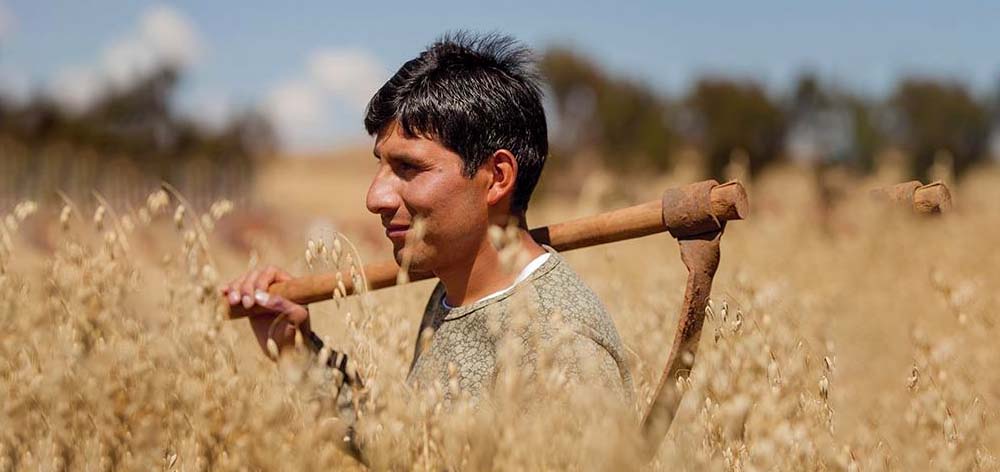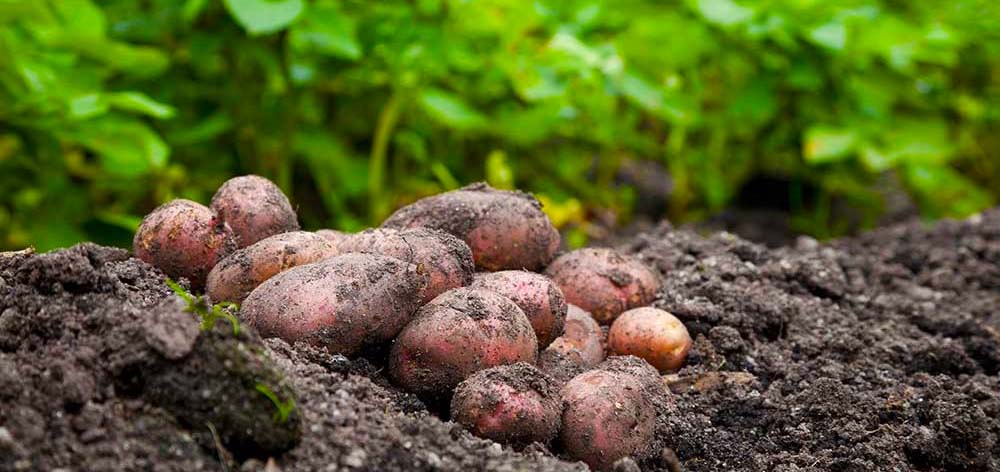In the early 2000s —long before my days at Terra Explorer Peru— my zealous forty-something dad worked for NGOs funded by European philanthropists seeking to accelerate social mobility within the ostracized rural communities in the far Andes of Peru.
And, every summer, my sister Lu and I packed our little cases and moved to whatever hamlet or town my dad was settled in at the time.
I vividly remember the absence of Coke at the local bodegas. Morning cereals were nowhere to be found. The farmers and herders there lived unacquainted with the ever-smiling faces of billboards pushing us, urbanites, towards the hamster wheel of perfectly packaged consumerism.
And yet, the pots there were never empty. You could always trust locals to have generous servings of quinoa, lamb, corn, potatoes —the latter, in countless shapes, and sizes, and colors. Yes, colors.

Purple and red potatoes
To pinpoint the very first time I tried a purple potato is just inviable. These flashy starchy tubers simply were part of my diet when going on family holidays with my dad. As far as seven-year-old me was concerned, they were what people ate. I never thought twice about it. I never revisited those past times with anything but fondness.
That was, until one day, as puberty hit —and as the age of the internet as we know it knocked on everyone’s doors— I made an equally amusing and bemusing discovery: Virtually no one had encountered purple potatoes during their lifetime. In fact, most people in the world are familiar with only one kind of potato.
But what inflamed me the most was the common and wrongful belief —even to this day!— that potatoes come from, um, Ireland? Are people that unmindful of colonial history? Do they know nothing about Columbus and the Inca Civilization? I queried myself as shock consumed every thought of mine.
It dawned on me: I’m one of the lucky few who has actually tasted purple potatoes. As I was questioning my not-so-common culinary experiences, Peruvian cuisine was bursting into the juggernaut it is today.
Chefs and restaurateurs in Lima turned to their own land in a genius move to cook over their eclectic history and deep-rooted traditions. And the likes of Mitsuharu Tsumura and Virgilio Martinez —running the celebrated restaurants Maido and Central—forged ahead into the pinnacle of the global gastronomic ladder.
With his sight on the most ancient of ingredients, Virgilio naturally comprehended the value of propelling those harnessing the centuries-old agrarian savoir-faire with him. It takes a genius to recognize a genius. And so, Manuel Choqque, a trailblazing agricultural engineer, and Virgilio Martinez, the most celebrated chef in Peru, became one and the same.
Related: Mil Centro: Virgilio Martinez’s Culinary Lab In The Sacred Valley

Manuel Choqque
Just last year, 2021, The World’s 50 Best laureled him as one of the fifty people “shaping the future of gastronomy.” His achievement should not be understated, as his story is as inspirational as it is rare.
Thirty-four years ago, Manuel was born in Chincheros, a remote agricultural community nestled within the mountains of the Sacred Valley. Like every generation before him, he grew among fields —cultivating potatoes, mashua, and oca.
Back then, and to this day, the markets pushed many farmers, like his family, towards the homogenization of potatoes: the larger and whiter, the better. He always wondered if he could ever change that.
Young Manuel grew determined to enroll in the San Antonio Abad University of Cusco Law School. Being a lawyer has historically been seen as a safe avenue for many juvenile men and women attempting to break off from the systemic poverty plaguing many communities in the Andes.
But one day, by virtue of luck, or causality, while attending a training school for the university’s entrance examination, he mistakenly crashed into a botany class. It was then that he unveiled that the knowledge he imbued on his entire life was just as deserving of a university degree as any other branch of knowledge.
“The countryside was speaking to me,” Manuel recalls. This was a turning point. A sort of metanoia. Enlivened, Manuel pursued agricultural engineering as his true passion. He got the fourth-highest score on the admission test.
After graduating, he worked four years for the Peruvian government, yet, his vibrant mind never charted away from the fields back home and that dream of his of turning the myriad of looked-down native potatoes into hot commodities.
His unyielding determination forced him to take an enormous leap of faith. In 2016, he renounced the nine to five to advance his unprecedented pioneering vision, one that would challenge every notion ever about what potatoes are.
He traversed the Andes, gathering every starchy tuber left behind by the machinery of offer and demand. He built the most extensive and most documented collection of hundreds of potatoes and polished them into the most exotic delicacies.
Choque perfected flavors, textures, colors and headed towards an unappreciative culinary industry. Likewise, he knocked on dozens of doors, one of them, Mil—Virgilio Martinez’s new restaurant in Maras, Cusco. Their values around ingredients could not be more aligned. They were meant to meet each other.
“We’re not talking about an ordinary producer. His work is revolutionary. He’s taking potatoes to new heights. He’s taking oca and mashua to new heights. And he is succeeding.”— Virgilio Martinez.
Related: 5 Must Go Restaurants In Peru

Andean potatoes
As of 2022, Manuel Choqque is yet to be a full-on marquee name; but his work has already caught the attention and admiration of the cuisine elites. Perfectly purple and blue potatoes make up his better-known oeuvre. And renowned chefs and gastronomists are rallying behind his scientific and agricultural efforts.
But Manuel’s ingenuity is ever-evolving, just as his work is ever-evolving. While researching oca (another Andean tuber), he measured enough sugar to ferment it into alcoholic beverages. After two years of testing, he launched the first-ever oca wine, Miskioca. Now, he and his family are producing rosé, white, red, and orange wines.
Each bottle of Miskioka is fermented for at least six months and then rests for 60 days before being served at Central and Mil. “Manuel is proving that they [potatoes] are not just a bunch of carbs but an essential part of Peruvian culture and tradition —one that should be honored and celebrated,” concluded The World’s 50 Best.
Manuel Choqque has enthralled many—myself included. And his genius mind is only exacerbated by his kind spirit. He and his hospitable family are now part of Terra Explorer‘s network of experts.
We’re now able to take travelers from all over the world into his state—a farm doubling as a lab for this masterful endeavor. This is the perfect destination for anyone keen on mixing community-based tourism and out-of-the-ordinary gastronomic experiences near Cusco.

In Terra Explorer, we have several itineraries for you. This and many other once-in-a-lifetime luxurious experiences in Peru. From exquisite cuisine to motorcycle rides around the arresting landscapes, get in touch with us, and we will help you design the trip of your dreams!
To ensure the well-being and safety of our travelers and staff throughout our operational chain, Terra Explorer will comply with the health and safety measures and protocols established by the Peruvian Association of Adventure Tourism and Ecotourism (APTAE), and implement the Covid-19 health and safety guidelines for adventure tourism developed by the Adventure Travel Trade Association (ATTA).
Our experiences are designed considering the least possible exposure, where the final destinations are usually remote places. By their very nature, our adventure activities are considered to be low risk, mainly because they are performed outdoors where ventilation is constant and making it easy to achieve social distancing.
During these times we are working together with a small staff of honorable people who have been part of the Terra Explorer family for many years. They and their families are aligned with the established health and safety measures. Employing these staff members also seeks to reactivate the local economy.
We guarantee a safe, soul-fulfilling trip to all our travelers for whom we make these adventures possible.
Terra Explorer will strictly comply with the safety, cleaning, and hygiene protocols during our internal processes, third parties, and throughout your trip. This involves:
Follow the instructions related to health and safety given by the Terra Explorer team and your guide, before and during your trip.
Stay home if:
With the intention of delivering the most flexibility at the time of confirming your trip, we will determine the amount of the initial deposit individually and according to your itinerary characteristics.
Secure your trip with a deposit and pay the rest in one or more payments, at a time that suits you best. Please make sure you adhere to our policy and pay in full at least 31 days prior to your trip date.
If you need to cancel your trip, we will apply the following flexible policies.
For more detailed information on our terms and conditions and Covid-19 policies, please contact us at [email protected]